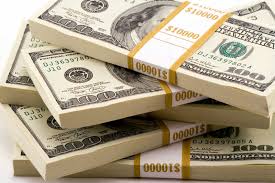NEW YORK
In times of uncertainty or crisis, investors typically take refuge in “safe” options like the Swiss franc, gold or the US dollar, but under President Donald Trump the greenback has lost its lustre, especially to the euro.
After this week’s North Korean missile launch over Japan raised fears it could trigger a major conflict, the single European currency rose above the symbolic threshold of $ 1.20 for the first time since January 2015.
“The dollar and US Treasuries are typically safe haven assets. But no one really wants to own the dollar right now,” said Jefferies Head of Foreign Exchange Trading Brad Bechtel.
US monetary policy also plays a role in the dollar’s relative value, as do comments — or the absence thereof — from central bankers.
“The lack of faith in the US administration and the fact that the Fed has been relatively clearly not anxious to hike rates again anytime soon, influence the dollar,” Bechtel said.
The US currency had benefited from the promises of economic reforms from candidate Trump at the end of 2016. But the president is finding it increasingly difficult to get his pro-growth agenda through Congress.
While economic growth is strong—hitting Trump’s three percent goal in the second quarter—inflation has been persistently weak, making the Fed reluctant to raise interest rates a third time this year, a move that would benefit the dollar.
Traders were very disappointed when Federal Reserve Chair Janet Yellen carefully avoided any discussion of monetary policy in a speech last week at the closely watched Jackson Hole central bankers’ forum.
EU INSPIRES CONFIDENCE:
Meanwhile, the euro is attracting more and more investors.
Thanks to the very accommodating monetary policy of the European Central Bank (ECB), interest rates remain very low, even negative, in the euro area.
That has made the single currency a funding vehicle for speculative trades, where investors borrow at a low-interest rate to move into assets with higher returns.
“The euro with the negative interest rate is a funding currency for carrying trade, like Japanese yen and Swiss franc,” said Greg Anderson of BMO Capital Markets.
But that means in a time of crisis, like this week, “In a flight to safety, people … have to buy euro.”
The economic and political situation in Europe also favours the single currency.
The region’s current account surplus “has gotten much bigger than it was in the past, which is a safe haven for a currency,” Anderson told AFP.
Meanwhile, the EU political situation has stabilised, especially after the Dutch and French elections in 2017.
“European countries have proved over the last five years they are able to do things in an emergency. And the US looks like a political mess right now,” Anderson said. “The political safety of the US dollar has been damaged.”
But Sireen Harajli, currency strategist at Mizuho, said that even so, the greenback “is still a safe haven currency.”
It would only take the Fed sending a positive signal or for good data on US employment, including wages, or inflation to revive the dollar.
And Anderson said the euro move to break the $1.20 threshold has made investors nervous.
They are “on pins and needles,” he said, waiting to see what the ECB will do.
“If they don’t do anything over the course of the next couple of weeks in terms of verbal intervention … probably the market will be disposed to push the euro higher against the dollar.”
























